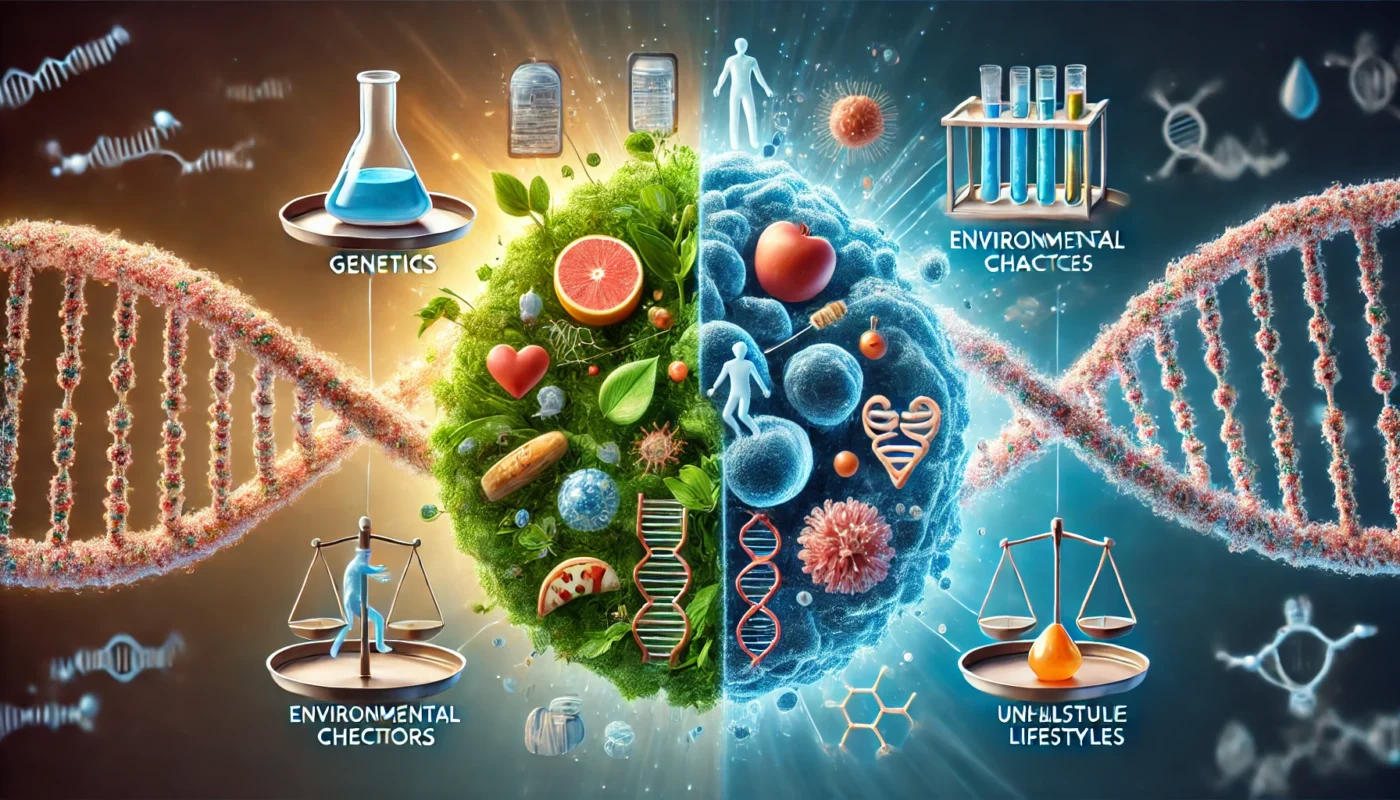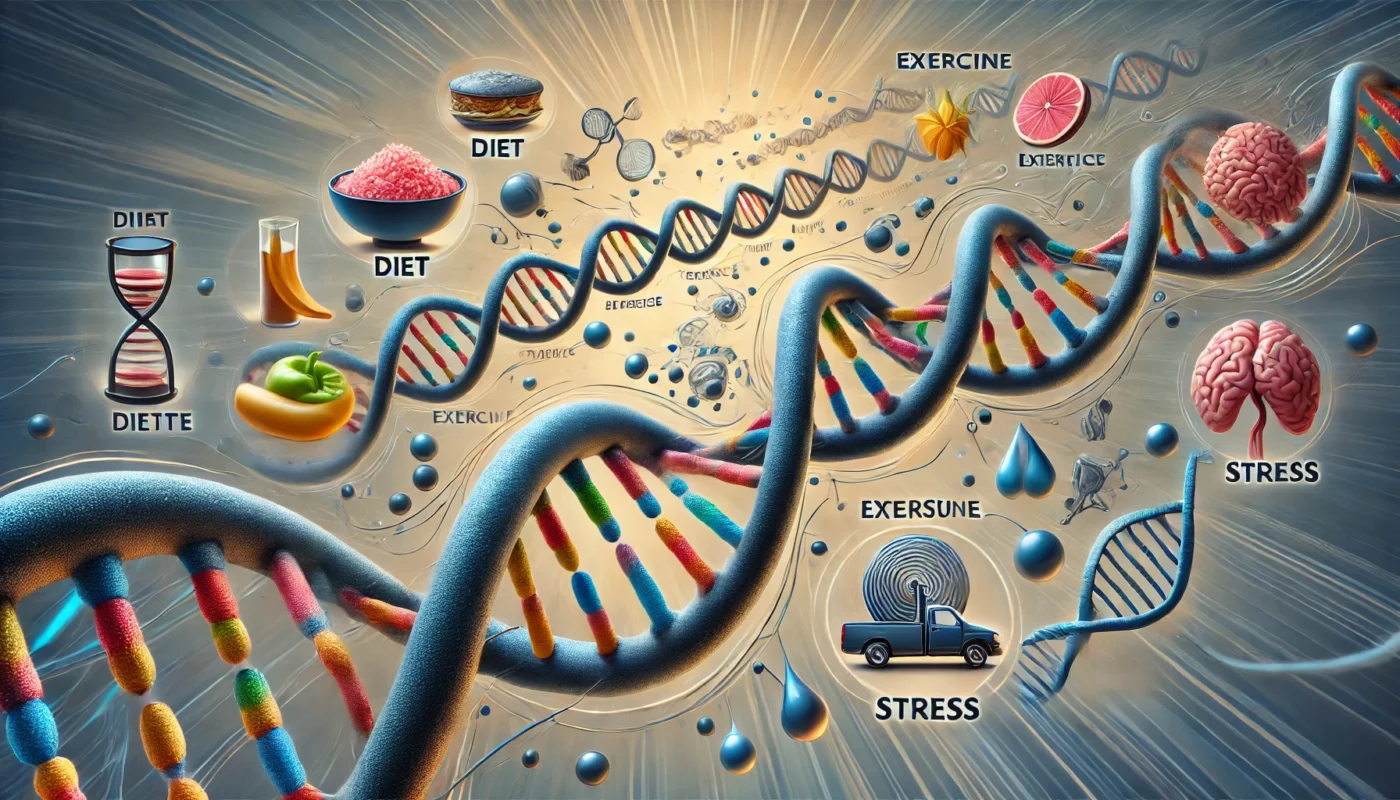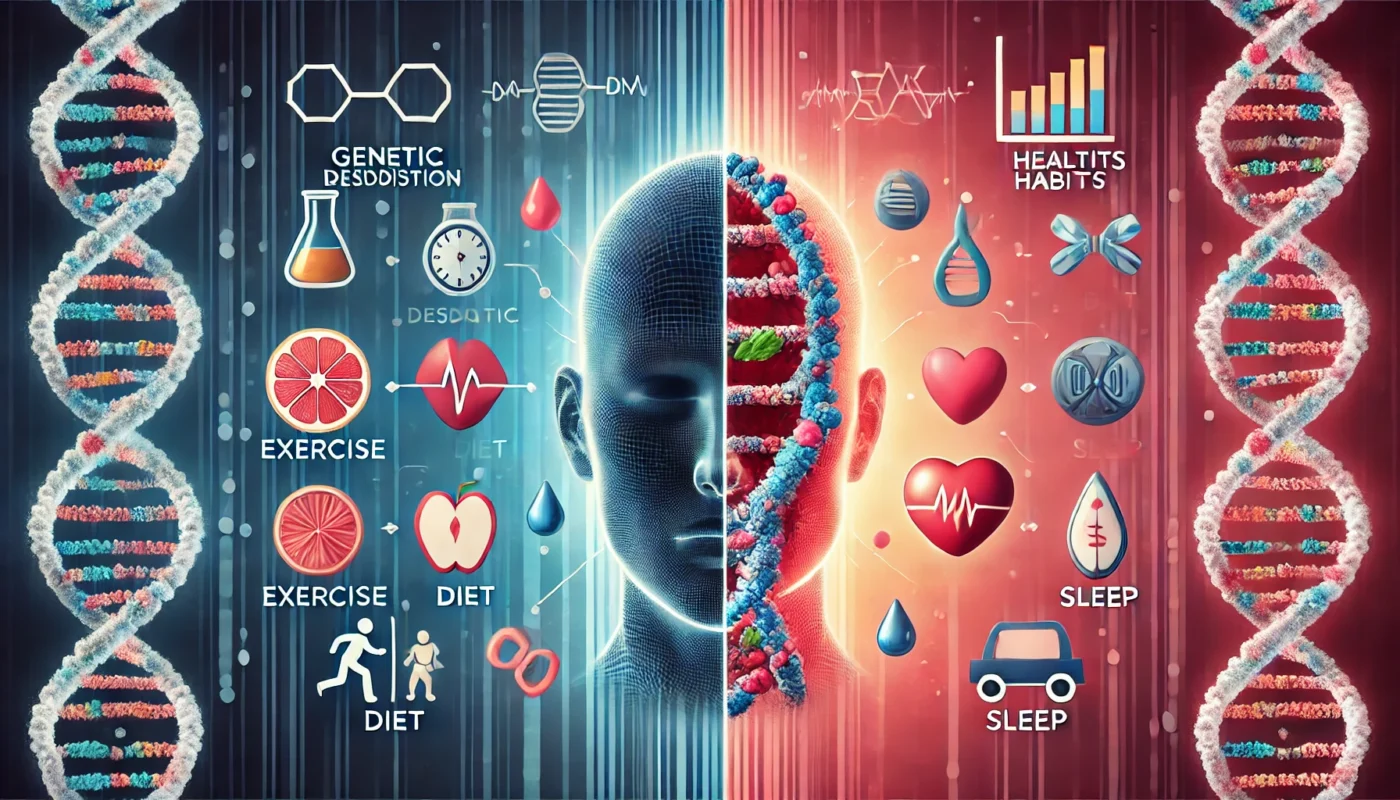In the realm of health and wellness, the body’s ability to heal is a captivating subject. It’s a fascinating intersection of biology, medicine, and personal lifestyle that raises intriguing questions: Why do some people seem to recover from injuries faster than others? Is it all down to genetics, or do lifestyle choices play a significant role? In this article, we’ll delve into the complex world of wound healing, exploring the genetic and lifestyle factors that influence the healing process.
You may also like: Key Factors in Proliferative Wound Healing

The Science of Wound Healing
Wound healing is a sophisticated biological process that kicks in the moment an injury occurs. It involves a series of well-coordinated phases: hemostasis, inflammation, proliferation, and remodeling. Each stage is crucial for the successful repair of tissue.
Hemostasis: The Immediate Response
Hemostasis is the body’s initial response to injury, and its primary goal is to prevent excessive blood loss. The body acts swiftly, activating platelets to form a clot at the injury site. This clot not only halts bleeding but also serves as a temporary barrier against pathogens. The speed and efficiency of this phase can vary based on factors like age, medication use, and overall health, setting the stage for subsequent healing processes.
The Role of Inflammation
Often misunderstood, inflammation is a critical component of the healing process. It marks the body’s defense mechanism at work, where white blood cells rush to the injury site to fend off infection and clear debris. While inflammation can cause discomfort and swelling, it is essential for cleaning the wound and paving the way for tissue repair. Understanding the balance between beneficial and excessive inflammation can help in managing recovery times effectively.
The Proliferation Phase: Building New Tissue
Once the wound is clean, the body transitions into the proliferation phase. This phase is characterized by the growth of new tissue, blood vessels, and the formation of a new extracellular matrix. Fibroblasts play a crucial role here, synthesizing collagen to provide structural support to the new tissue. The efficiency of this phase can be influenced by factors such as nutrient availability and oxygen supply, highlighting the importance of a supportive healing environment.
Remodeling: Strengthening the Repair
The final phase of wound healing is remodeling, which can last several months. During this phase, collagen fibers reorganize, and the tissue gains strength and flexibility. This phase ensures that the tissue not only closes but also regains its pre-injury function and appearance. External factors, such as physical therapy and proper wound care, can significantly impact the quality of the remodeled tissue.
Do Some People Heal Faster Than Others?
Indeed, the rate of healing varies significantly from person to person. This variance is often attributed to a combination of genetic predispositions and lifestyle choices. Let’s unpack these factors:
The Genetic Influence
Genetics plays a fundamental role in determining the efficiency of the healing process. Our genetic makeup can influence everything from the speed at which cells divide to the body’s inflammatory response.
Inherited Healing Traits
Some people inherit genes that allow for a quicker inflammatory response, which can expedite the healing process. These genetic traits can be traced back to evolutionary adaptations that favored rapid recovery in environments where injury was common. Understanding these inherited traits can provide insights into personalized healing strategies.
Collagen Production and Genetic Variability
Genetic factors can dictate the production of collagen, a vital protein in wound healing, impacting the structural integrity of the newly formed tissue. Variations in collagen-related genes can lead to differences in scar formation and tissue strength, highlighting the need for tailored approaches to wound care based on genetic profiles.
Genetic Research and Future Therapies
Ongoing genetic research aims to identify specific genes involved in wound healing, opening doors to future therapies that can enhance natural healing capabilities. Gene editing technologies like CRISPR hold potential for correcting genetic deficiencies that impede healing, ushering in a new era of regenerative medicine.
Lifestyle Choices and Their Impact
While we cannot change our genetic code, lifestyle choices are within our control and can significantly affect healing speed.
Nutrition: Fueling the Healing Process
A balanced diet rich in vitamins and minerals is pivotal for optimal healing. Nutrients such as vitamin C, zinc, and protein play essential roles in cell repair and immune function.
The Role of Essential Nutrients
For instance, vitamin C is crucial for collagen synthesis, while zinc aids in DNA synthesis and cell proliferation. Omega-3 fatty acids, found in fish oil, can also reduce inflammation and promote faster recovery. Incorporating a variety of nutrient-dense foods ensures that the body has all the building blocks it needs for efficient healing.
Hydration and Healing
Hydration is often overlooked but is equally vital for healing. Proper fluid balance supports cellular functions and the transport of nutrients to the injury site. Staying well-hydrated ensures that the circulatory system can deliver essential elements needed for tissue repair.
Dietary Supplements: Aiding Recovery
In some cases, dietary supplements can support the healing process, especially when dietary intake is insufficient. Consulting with healthcare professionals can guide appropriate supplementation, such as adding vitamin D to support immune function or using protein supplements to meet increased demands during recovery.
Exercise: Balancing Activity and Rest
Regular physical activity boosts circulation, ensuring that oxygen and vital nutrients are efficiently delivered to the site of injury.
Circulation and Healing
Improved circulation facilitates the removal of waste products and the delivery of healing nutrients to the wound site. Activities like walking or gentle stretching can enhance blood flow without overstressing the body, providing a supportive environment for healing.
Finding the Right Balance
However, it’s a delicate balance, as excessive exercise can lead to stress on the body, potentially hindering the healing process. Understanding the limits of one’s body and incorporating rest days can prevent overexertion and promote a steady recovery.
Rehabilitation and Physical Therapy
For more significant injuries, rehabilitation and physical therapy can aid in recovery, helping restore function and strength. These programs are tailored to individual needs, ensuring that exercise supports rather than hinders healing.
Sleep: The Unsung Hero of Recovery
Quality sleep is often underestimated in its role in healing. During sleep, the body goes into repair mode, producing growth hormones essential for tissue regeneration.
The Science of Sleep and Healing
A consistent sleep schedule can accelerate recovery times and bolster the immune system. Deep sleep stages are particularly important, as this is when the body focuses on repair and regeneration processes. Prioritizing sleep hygiene can have a profound impact on healing efficiency.
Sleep Disorders and Healing
Sleep disorders, such as insomnia or sleep apnea, can impair the body’s ability to heal. Addressing these issues through medical intervention or lifestyle changes can improve overall recovery outcomes.
Napping as a Recovery Tool
Short naps can also serve as a valuable tool for recovery, providing an additional opportunity for the body to engage in repair processes. Strategic napping can complement nighttime sleep, especially during periods of increased physical stress or injury.
Stress Management: Healing the Mind and Body
Chronic stress can have a detrimental effect on the healing process. Stress hormones, such as cortisol, can impair the body’s inflammatory response and slow down tissue repair.
The Impact of Stress on Healing
Chronic stress can weaken the immune system, making the body more susceptible to infections and prolonging the healing process. Recognizing the signs of stress and implementing effective management strategies can significantly influence recovery times.
Mindfulness and Relaxation Techniques
Mindfulness practices, such as meditation and yoga, can mitigate stress and promote faster healing. These practices encourage relaxation and can lower stress hormone levels, creating a more conducive environment for healing.
Social Support and Healing
Social support is another crucial aspect of stress management. Engaging with friends, family, or support groups can provide emotional comfort and reduce stress, indirectly boosting the body’s ability to heal.

Historical Context and Current Trends
Throughout history, various cultures have sought to understand and influence the healing process. From the ancient Egyptians using honey as a natural antibacterial agent to modern advancements in regenerative medicine, our understanding of wound healing has evolved dramatically.
Ancient Practices and Remedies
Ancient civilizations developed diverse methods to aid healing, often relying on natural remedies and traditional knowledge. For instance, the use of honey and aloe vera was prevalent due to their antibacterial and soothing properties. Understanding these traditional practices provides valuable insights into the origins of contemporary healing methods.
Herbal Medicine and Traditional Knowledge
Herbal medicine has been a cornerstone of healing for centuries. Many herbs, such as calendula and chamomile, have been used for their anti-inflammatory and soothing properties. These traditional remedies are still used today, offering complementary options alongside modern medicine.
Cultural Variations in Healing Approaches
Different cultures have unique approaches to healing, reflecting their understanding of the body’s processes. Traditional Chinese Medicine and Ayurveda emphasize balancing the body’s energy and using natural elements to support healing. These cultural perspectives enrich the global understanding of wound care and recovery.
Modern Advances in Healing
In recent years, technology and medicine have introduced innovative methods to enhance healing. Techniques such as hyperbaric oxygen therapy, which increases oxygen supply to tissues, and the use of growth factors and stem cells to promote tissue regeneration, are at the forefront of medical research.
Hyperbaric Oxygen Therapy
Hyperbaric oxygen therapy involves breathing pure oxygen in a pressurized chamber, boosting oxygen levels in the blood and promoting faster healing. This therapy is particularly effective for chronic wounds and injuries that struggle to heal under normal conditions.
Stem Cells and Regenerative Medicine
The use of stem cells in regenerative medicine represents a groundbreaking advancement in healing. Stem cells have the unique ability to differentiate into various cell types, offering potential for regenerating damaged tissues and organs. Research in this area continues to evolve, promising new possibilities for enhancing the body’s natural healing capacity.
Growth Factors and Healing
Growth factors are proteins that play a crucial role in cell growth and division. Applying growth factors to wounds can accelerate the healing process, making them a valuable tool in modern wound care. These advancements highlight the intersection of biotechnology and traditional healing practices.
Future Implications and Personalized Medicine
Looking ahead, the integration of personalized medicine, which tailors treatments based on an individual’s genetic profile, promises to revolutionize wound care. As we continue to unravel the complexities of the human genome, the potential to optimize healing processes through genetic insights becomes increasingly attainable.
Genetic Profiling for Tailored Treatments
Advancements in genetic profiling allow for the identification of individual genetic factors influencing healing. This knowledge can guide personalized treatment plans, ensuring that interventions align with a person’s unique genetic makeup.
The Role of AI and Machine Learning
Artificial intelligence and machine learning are playing an increasingly important role in personalized medicine. By analyzing vast amounts of genetic and health data, AI can predict healing outcomes and suggest optimal treatment strategies, paving the way for more efficient and effective care.
Ethical Considerations in Genetic Medicine
As genetic insights become integral to wound care, ethical considerations surrounding privacy and consent are paramount. Ensuring that individuals have control over their genetic information and understanding the implications of genetic interventions are critical components of future medical practices.

Practical Advice for Optimizing Healing
For health and wellness coaches, science journalists, and biohackers alike, understanding the interplay between genetics and lifestyle choices is key to optimizing healing. Here are some practical steps to consider:
- Prioritize Nutrition: Ensure a diet rich in essential nutrients to support cellular repair and immune function.Emphasize a variety of fruits, vegetables, lean proteins, and whole grains to provide a comprehensive nutrient profile.Consider consulting with a nutritionist to address specific dietary needs and optimize nutrient intake for healing.Stay informed about the latest research on nutrition and healing to make evidence-based dietary choices.
- Engage in Moderate Exercise: Incorporate regular physical activity to enhance circulation without overstraining the body.Focus on low-impact exercises such as walking, swimming, or cycling to promote blood flow and support recovery.Incorporate strength training and flexibility exercises to maintain muscle mass and joint health during the healing process.Monitor exercise intensity and adjust routines based on feedback from your body to prevent setbacks.
- Maintain a Consistent Sleep Schedule: Prioritize quality sleep to facilitate tissue regeneration and immune support.Create a relaxing bedtime routine to signal to your body that it’s time to wind down and prepare for restful sleep.Optimize your sleep environment by ensuring a comfortable mattress, a cool room temperature, and minimal noise and light.Track sleep patterns with wearable technology to identify potential issues and make adjustments for better rest.
- Manage Stress Effectively: Implement stress-reduction techniques to mitigate the negative impact of stress hormones on healing.Explore various stress management practices, such as mindfulness meditation, deep breathing exercises, or progressive muscle relaxation.Engage in activities that bring joy and relaxation, such as reading, listening to music, or spending time in nature.Seek professional support or counseling if stress becomes overwhelming, ensuring mental and emotional well-being during recovery.
In conclusion, while genetics lays the foundation for our healing capabilities, lifestyle choices play a crucial role in shaping the healing process. By embracing a holistic approach that considers both genetic predispositions and lifestyle modifications, we can enhance our body’s natural ability to heal, leading to improved health and wellness outcomes. This comprehensive understanding empowers individuals to make informed decisions that optimize their healing potential and overall well-being.
Further Reading:
Why wavy wounds heal faster than straight wounds
Our Perception of Time Can Actually Speed Up Wound Healing
Do Your Wounds Take Forever to Heal? Your Genes Could Be the Reason
Herbal medicine, healing, traditional remedies, cultural variations, modern medicine, hyperbaric oxygen therapy, stem cells, regenerative medicine, growth factors, personalized medicine, genetic profiling, artificial intelligence, machine learning, ethical considerations, nutrition, exercise, sleep, stress management, wellness, health optimization
Important Note: The information contained in this article is for general informational purposes only, and should not be construed as health or medical advice, nor is it intended to diagnose, prevent, treat, or cure any disease or health condition. Before embarking on any diet, fitness regimen, or program of nutritional supplementation, it is advisable to consult your healthcare professional in order to determine its safety and probable efficacy in terms of your individual state of health.
Regarding Nutritional Supplements Or Other Non-Prescription Health Products: If any nutritional supplements or other non-prescription health products are mentioned in the foregoing article, any claims or statements made about them have not been evaluated by the U.S. Food and Drug Administration, and such nutritional supplements or other health products are not intended to diagnose, treat, cure, or prevent any disease.

